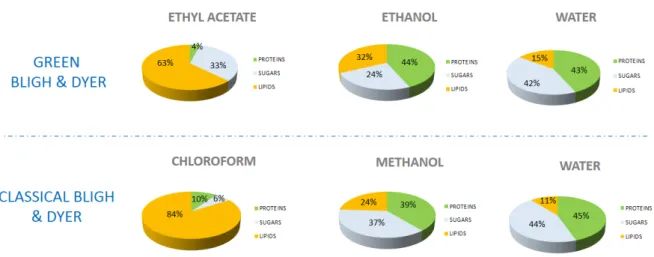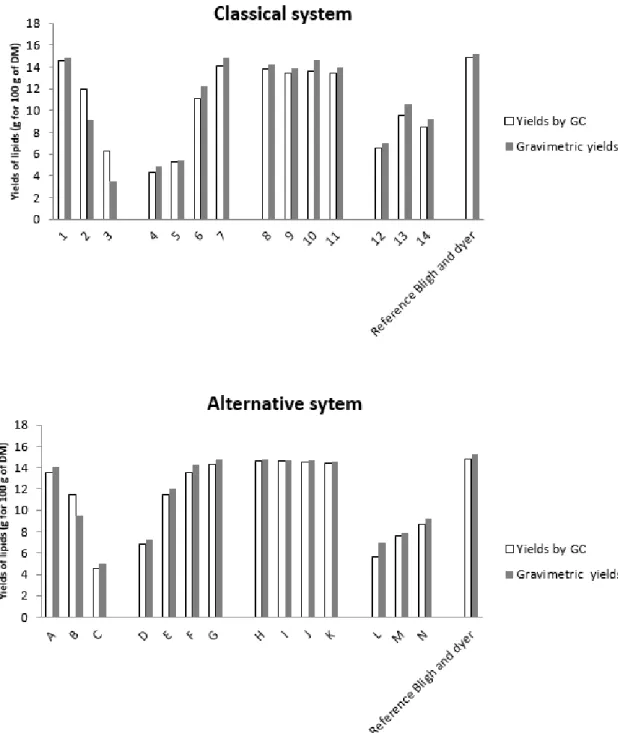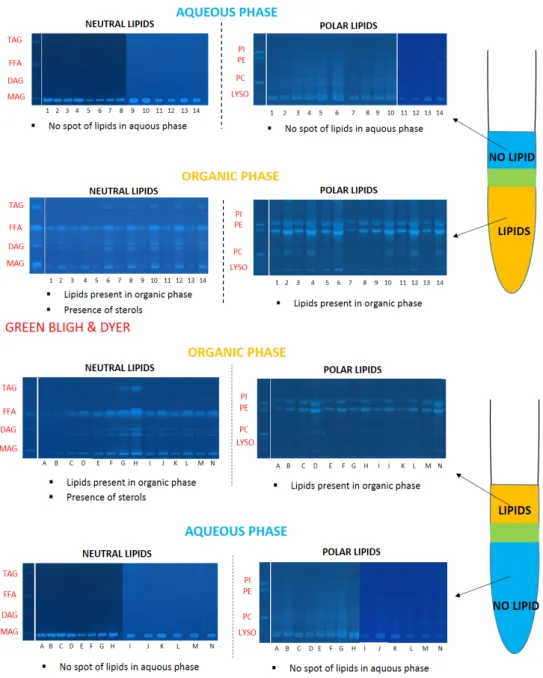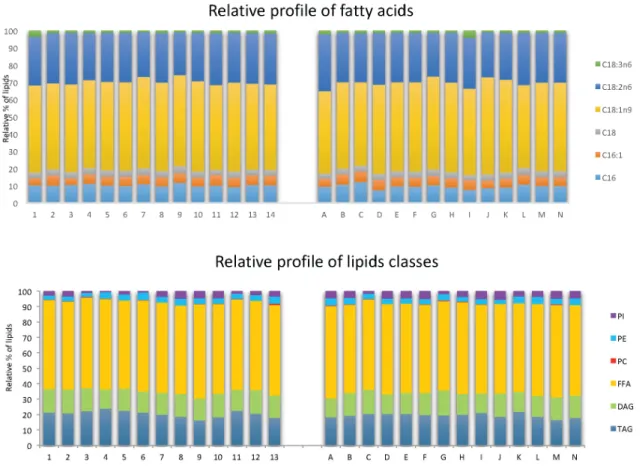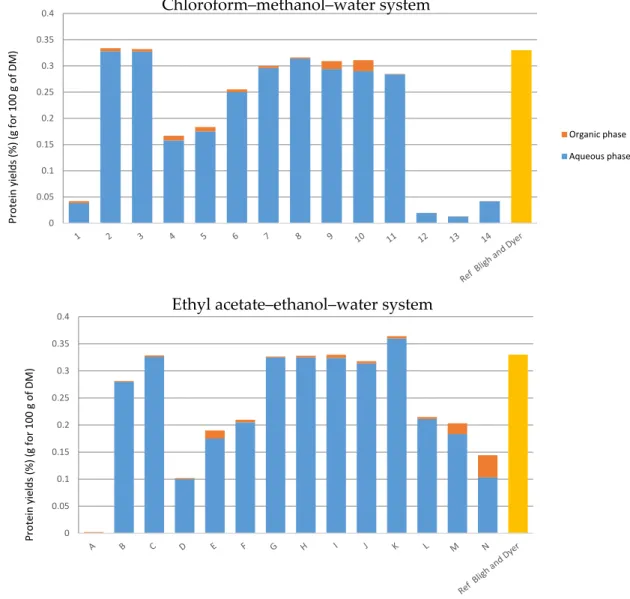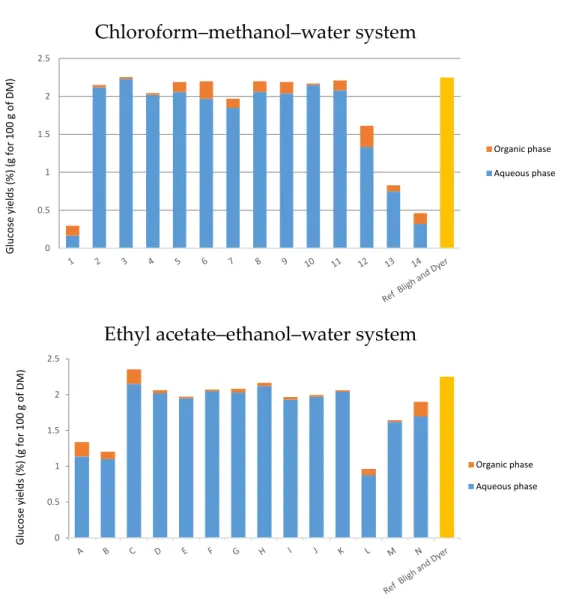Article
“Bligh and Dyer” and Folch Methods for
Solid–Liquid–Liquid Extraction of Lipids from Microorganisms. Comprehension of Solvatation Mechanisms and towards Substitution with
Alternative Solvents
Cassandra Breil1, Maryline Abert Vian1, Thomas Zemb2, Werner Kunz3and Farid Chemat1,*
1 GREEN (Groupe de Recherche en Eco-Extraction de Produits Naturels),
Universitéd’Avignon et des Pays du Vaucluse, INRA, UMR 408, GREEN, F-84000 Avignon, France;
cassandra.breil@alumni.univ-avignon.fr (C.B.); maryline.vian@univ-avignon.fr (M.A.V.)
2 Institut de Chimie Séparative de Marcoule, F-30207 Bagnols Sur Cèze, France; thomas.zemb@icsm.fr
3 Institute of Physical and Theoretical Chemistry, University of Regensburg, D-93040 Regensburg, Germany;
werner.kunz@chemie.uni-regensburg.de
* Correspondence: farid.chemat@univ-avignon.fr; Tel.: +33-490-144-440 Academic Editor: David Arráez-Román
Received: 21 February 2017; Accepted: 19 March 2017; Published: 27 March 2017
Abstract: Bligh and Dyer (B & D) or Folch procedures for the extraction and separation of lipids from microorganisms and biological tissues using chloroform/methanol/water have been used tens of thousands of times and are “gold standards” for the analysis of extracted lipids. Based on the Conductor-like Screening MOdel for realistic Solvatation (COSMO-RS), we select ethanol and ethyl acetate as being potentially suitable for the substitution of methanol and chloroform. We confirm this by performing solid–liquid extraction of yeast (Yarrowia lipolytica IFP29) and subsequent liquid–liquid partition—the two steps of routine extraction. For this purpose, we consider similar points in the ternary phase diagrams of water/methanol/chloroform and water/ethanol/ethyl acetate, both in the monophasic mixtures and in the liquid–liquid miscibility gap. Based on high performance thin-layer chromatography (HPTLC) to obtain the distribution of lipids classes, and gas chromatography coupled with a flame ionisation detector (GC/FID) to obtain fatty acid profiles, this greener solvents pair is found to be almost as effective as the classic methanol–chloroform couple in terms of efficiency and selectivity of lipids and non-lipid material. Moreover, using these bio-sourced solvents as an alternative system is shown to be as effective as the classical system in terms of the yield of lipids extracted from microorganism tissues, independently of their apparent hydrophilicity.
Keywords:Bligh and Dyer; Folch; bio-sourced solvent; yeast; lipids
1. Introduction
Lipids from microorganisms’ matrices such as microalgae or yeasts are hydrophobic molecules which are soluble in many organic solvents. They can be divided according to the polarity of their head groups: neutral lipids (acylglycerols, free fatty acids, sterols, sterols esters, waxes and hydrophobic pigments) [1] which are synthetized by the cells to store energy, and polar lipids (phospholipids, glycolipids, polysaccharides and proteins) which are the matrix of the cellular membrane. Estimation of the total lipids content in a microorganism sample is crucial for various kinds of applications such as biodiesel [2], nutritional supplements [3], cosmetic [4], etc.
Int. J. Mol. Sci.2017,18, 708; doi:10.3390/ijms18040708 www.mdpi.com/journal/ijms
The safest and nowadays most popular way to ensure that all of the cellular lipids are extracted is to employ a ternary solvent composition including a polar as well as a non-polar solvent. The first step is a solid–liquid extraction from an initial amorphous gel state, followed by a second liquid–liquid partitioning step. In the second step, the initially extracted mixture of all biomolecules is separated into two phases: an organic-rich phase (OR) containing the total lipids and a water-rich phase (WR) containing others compounds (sugars, proteins, etc.).
The standard of these solvent mixtures is chloroform–methanol, described for the first time more than 50 years ago by Folch [5,6] and Bligh and Dyer [7] (B & D) and cited more than 50,000 times in the “experimental” section of papers describing the analytics of lipids and proteins extracted and separated with high efficiency form micro-organisms.
The crucial point in the second step is the partial miscibility of the chloroform in the WR phase and the water in the OR phase [8]. This ensures that all biomolecules, independent of their volume and “hydrophilicity”, are solubilized either in the OR or in WR coexisting phases.
The sample of biological origin is mixed with water, methanol and chloroform in solvent ratios to form a monophasic ternary solvent mixture. In this region of the phase diagram, no structuring appears and predictions of models based on random phase approximation such as COSMO-RS are expected to be good. By adding a sufficient amount of water, a biphasic system is then spontaneously formed leading to the partitioning of proteins [9], carbohydrates [10] and phospholipids [11] into the WR-rich upper-layer (essentially water–methanol) and non-polar components such as most lipids into a hydrophobic, chloroform-rich lower layer [12]. These two layers are in equilibrium via exchange through the meniscus, i.e., water, chloroform as well as ethanol chemical potentials are the same in the two phases. Both layers are nanostructured close to a critical point. Further, the WR layer requires less cost in free energy to insert proteins, while the OR layer is an efficient host for all types of lipids present, independent of their intrinsic hydrophilicity.
These above-mentioned gravimetric methods are still widely used for the estimation of lipids in hospital, pharmaceutical, food, or biofuel laboratories [13]. However, these methods have serious disadvantages in terms of safety, especially with chloroform, which is highly toxic and carcinogenic [11], making it inappropriate for large-scale application.
In order to improve these basic methods of Folch or B & D, many researchers adopted modifications concerning the substitution of hazardous solvents. Atsushi et al. were the first to substitute the chloroform–methanol system by hexane–isopropanol mixtures [14]. Despite this initial breakthrough, the results showed a lower efficiency. Several years later, more studies have been pursued by several teams such as Molina Grima [15], Lee [16], Sheng [17], Caprioli [18]
and many others, that have shown the effectiveness of many promising solvents to replace the chloroform–methanol mixture. However, these methods still remain toxic to human health and the environment. Nowadays, scientific and industrial research laboratories face the challenge of finding an appropriate extraction method with minimum energy consumption and greener solvents [19] such as the last work of the research laboratory of Wallenberg using heptane and ethyl acetate as alternative solvents [20]. Since the Folch as well as the Bligh and Dyer methods for total determination of lipids were published, a large number of publications appeared showing modifications or intensifications of both methods. They have been reviewed by Iverson and coworkers [21]. Among them, the use of ultrasound [1,22–24], microwaves [16,22,23,25,26], heat [25,27], pressure [27,28] or beads [24,27]
were often raised to improve the efficiency of lipid recovery from various tissues such as bacteria [23], yeasts [29] or microalgae [30] (supplementary material). However, all these methods were using solvents of fossil origin issued from petrol.
From the point of view of environmental protection and the development of green chemistry, toxic petroleum solvents will have to be replaced in the future by bio-sourced solvents (or “bio-solvents”) [31].
In this paper, we compare the performances of several alternative solvents to substitute chloroform–methanol mixtures used in the Folch and B & D protocols for the extraction of Yarrowia lipolytica(Y.L), a well-known oleaginous organism proven to be suitable for many different industrial processes such as the production of biodiesel fuel, functional fatty acids and carotenoids.
First, the theoretical approach of the conductor-like screening model for realistic solvation (COSMO-RS) was used to simulate the relative solubility of the solutes (free fatty acids (FFAs), diglycerides (DAGs), triglycerides (TAGs), phospholipids (PLs), proteins, polysaccharides, glucose, amino acids and sterols from the microorganism sample) in several selected alternative solvents: 2-methyltetrahydrofuran (MeTHF), cyclopentyl methyl ether (CPME), ethyl acetate (EtOAc), ethyl lactate, dimethyl carbonate (DMC),p-cymene,d-limonene andα-pinene as potential substitutes of chloroform; and ethanol (EtOH) and isopropanol (IPA) to substitute methanol.
In the course of further selection of solvents, we keep the common strategy of Folch and B & D protocols which are based on two-step solid/liquid and then liquid/liquid extraction methods with partition of hydrophobic lipids to an organic solvent-rich ternary fluid phase, while unwanted compounds are partitioned in the water-rich phase. Lipids extracted in both phases are analyzed by high thin layer chromatography (HPTLC) to obtain quantities of extracted lipids by lipid classes and by gas chromatography coupled with a flame ionization detector (GC/FID) in order to obtain the fatty acid profiles. Sugars and proteins are quantified by the UV spectrometry method.
2. Results and Discussion
2.1. Bligh and Dyer: Principle
The B & D method has been considered as the standard method for the determination of total lipids in biological tissues such as microorganisms. Methanol, chloroform and water are added to the sample in a two-step extraction and, after phase separation, lipids are quantified in the chloroform phase.
The compounds with a known amount of water (80%) are dissolved in this binary system and are then separated by transition from the monophasic system to the biphasic system induced by the addition of water: the final composition is located inside the miscibility gap: two samples with compositions given by the points at the end of the tie-line coexist [32]. The partition of compounds between the WR and the OR phases can be estimated in a first approximation by Hansen’s solubility parameters as a roughly quantitative description of “like dissolves like”; the proteins and sugars are preferably partitioned into the WR layer and lipids into the OR layer. The adding of potassium chloride in the separation step can modify the distribution of lipids between the two phases and is sometimes considered as a substance that favours lipid exchange between the aqueous phase and the organic phase. This phenomenon is supposed to be due to cations generated by the salts (KCl) which decreased the dissociation of lipids by a mass action effect, which, therefore, shift lipids to the OR phase, keeping salts in the WR phase [6]. It can be also considered as a typical salting-out effect.
Nowadays, the use of hazardous and toxic solvents such as chloroform and methanol in the chemical sector (laboratories and industry) is considered as a very important problem for the health and safety of workers and environmental concerns. The green chemistry approach aims to substitute toxic solvents by greener alternatives. In the case of extraction, chlorinated solvents and methanol are two typical examples of such problematic solvents. Consequently, investigations of alternative solvents have been done following the same principles as for conventional B & D extraction.
2.2. Strategy for Selection of Bio-Sourced Solvents: COSMO-RS Approach
In the present case,Y.Lyeast biomass was used as the lipid matrix. Thus, molecules synthetized byY.LIFP29 were determined thanks to a preliminary study [11] performed with the same yeast.
A simulation with this software was conducted to determine the solubility of the synthetized molecules by yeasts such as free fatty acids (oleic acid, linoleic acid, stearic acid), triglycerides, diglycerides, polar lipids (phosphatidylethanolamine, phosphatidylcholine) [11], sterols (lanosterol and ergosterol) [13],
polysaccharides (1,3 bd glucan, 1,4 bd glucan and chitin) [33,34], amino acids (arginine and histidine) and sugars (glucose), in the collection of solvents considered. Regarding the results given by COSMO-RS predictions of convenient solvents, two of them were selected: isopropanol and ethanol.
Bio-isopropanol derived fromE. colibacteria via fermentation [35], allows the solubilization of almost all kinds of model compounds in contrast to ethanol, which is selective only towards polar lipids and sterols, polysaccharides, glycerol and amino acids. Moreover, ethanol can be obtained from agricultural resources via fermentation thanks to many bacteria [36–38].
Eight alternative solvents were selected to replace chloroform: ethyl acetate, 2-methyltetrahydrofuran (MeTHF), cyclopenthylmethylether (CPME), dimethylcarbonate (DMC), ethyl lactate, α-pinene, d-limonene and p-cymene. A priori, the best candidate should have polarity properties similar to chloroform. However, several additional properties have to be considered further to solubility, such as volatility, viscosity, energy required for elimination [39] and ability to form a two-phase system with water. According to these requirements, ethyl acetate, MeTHF and CPME turned out to be the most appropriate alternative solvents. However, although CPME can be considered as a “greener” solvent compared to chloroform, because it is in agreement with green chemistry principles 1, 5 and 12 [40], it is not bio-sourced [41]. Ethyl acetate and MeTHF forming a ternary system with water, are able to create a biphasic system under specific conditions and are considered as being bio-sourced solvents.
According to COSMO-RS simulations, shown in Table1, MeTHF is not selective enough for proteins, polysaccharides and glucose. So, according to this theoretical work, ethyl acetate was considered to be the most appropriate solvent to replace chloroform.
2.3. Partition of Macro-Constituents from Y.L Yeast into Pure Solvents
In this part, the solubility of constituents fromY.Lyeast such as lipids, proteins and sugars was studied in each pure solvent of the B & D procedure and bio-sourced solvents as pre-selected based on the computational study with COSMO-RS: ethyl acetate and ethanol.
According to Figure1, chloroform and ethyl acetate phases contain mainly lipids (respectively 84%
and 63%) and solubilize, in smaller amounts, proteins (4% and 10%) and sugars (6% and 33%).
These results show that chloroform is more selective towards lipids than ethyl acetate.
Ethanol and methanol are respectively mixed in the aqueous phases; they solubilize sugars (respectively, 24% and 37%), proteins (44% and 39%) and lipids (32% and 24%) such as polar lipids and free fatty acids. The solubility of lipids in methanol or ethanol is lower than in chloroform or in ethyl acetate, but higher for glucose and proteins.
Water extracts about 43% of proteins, 44% of glucose and 13% of lipids (being nonpolar, lipids are hardly solubilized).
These results are in good agreement with the “like dissolves like” empirical rule. It is based on the polarity of the systems; polar molecules dissolve in polar solvents (alcohol, water) and non-polar solvent molecules in non-polar solvents.
As shown in the Table1, no significant differences exist between the theoretical predictions and the experimental results. In both cases, ethyl acetate and chloroform have a high solubility power for lipids. Moreover, ethyl acetate extracts glucose (33%), which was also predicted by COSMO-RS.
According to simulations, ethanol and methanol are less efficient than other solvents (chloroform and ethyl acetate) to solubilize lipids, which was experimentally confirmed by lower lipid extraction yields. Concerning water, the experimental results confirm the expected high solubility of proteins and glucose, which is also consistent with the predicted COSMO-RS values. Furthermore, as also expected and predicted, water solubilizes 250 times less lipids than the others solvents investigated.
Table 1. Conductor-like Screening MOdel for realistic Solvatation (COSMO-RS) results; simulation of modeled molecules in several alternative solvents for the substitution of chloroform and methanol. Green (0), yellow (−0.1≤x≤ −0.99), red (−1≤x≤ −5).
Solvents/Molecules TAG LLL
TAG LOO
TAG OOO
DAG LGL
DAG LGO
DAG OGO
FFA18 1n9
FFA18 2n6
FFA 16
PC LL
PC OL
PE LL
PE
OL Lanosterol Ergosterol 1.6 bd Glucan
1.4 bd
Glucan Chitine Glycerol Histidine Arginine Glucose Water −23.96 −24.57 −24.55 −15.09 −17.26 −16.23 −8.18 −7.99 −7.67 −7.86 −5.92 −14.56 −14.13 −10.05 −9.19 0.00 −1.01 −0.21 0.00 0.00 0.00 0.00
Methanol −3.97 −4.36 −4.39 0.00 −2.73 −1.98 −0.13 −0.26 −0.30 0.00 0.00 −0.11 −0.08 0.00 0.00 0.00 0.00 0.00 0.00 0.00 0.00 0.00
Ethanol −2.11 −2.41 −2.40 0.00 −0.99 −0.11 −0.10 −0.13 0.12 0.00 0.00 −0.27 −0.16 0.00 0.00 0.00 0.00 0.00 0.00 0.00 0.00 0.00
Isopropanol 0.00 0.00 0.00 −0.19 −0.07 −0.20 0.00 0.00 0.00 0.00 0.00 0.00 0.00 0.00 0.00 0.00 0.00 0.00 0.00 0.00 0.00 0.00
Chloroform 0.00 0.00 0.00 0.00 0.00 0.00 −0.39 −0.17 −0.29 0.00 0.00 0.00 0.00 0.00 −0.22 0.00 −3.65 0.00 0.00 0.00 0.00 −4.66
Ethyl acetate 0.00 0.00 0.00 0.00 0.00 0.00 0.00 0.00 0.00 0.00 0.00 0.00 0.00 0.00 0.00 −7.86 −5.92 −14.56 −14.13 −17.48 −20.22 0.00
MeTHF 0.00 0.00 0.00 0.00 0.00 0.00 0.00 0.00 0.00 0.00 0.00 0.00 0.00 0.00 0.00 0.00 0.00 0.00 0.00 0.00 0.00 0.00
CPME 0.00 0.00 0.00 0.00 0.00 0.00 0.00 0.00 0.00 −0.95 −0.21 0.00 0.00 0.00 0.00 −2.25 0.00 0.00 0.00 0.00 −3.08 0.00
DMC −0.17 −0.10 −0.10 −0.10 −0.24 −0.19 −0.10 0.00 −0.20 0.00 0.00 −0.65 −0.21 −0.09 −0.06 −0.17 0.00 0.00 0.00 −0.28 −0.20 0.00
Ethyl lactate −2.71 −3.24 −3.24 0.00 −1.60 −0.09 −0.15 −0.04 −0.14 0.00 0.00 −0.07 −0.04 0.00 0.00 0.00 0.00 0.00 0.00 0.00 0.00 0.00
α−Pinene 0.00 0.00 0.00 0.00 −0.19 −0.17 0.00 0.00 0.00 −3.52 −4.56 0.00 0.00 0.00 0.00 −9.94 0.00 0.00 0.00 0.00 0.00 0.00
d−Limonene 0.00 0.00 0.00 −0.20 −0.10 −0.37 0.00 0.00 0.00 −2.93 −3.97 0.00 0.00 −0.07 0.00 −9.29 −8.71 −7.64 −5.11 −4.85 −7.25 −7.55
p−Cymene 0.00 0.00 0.00 −0.17 −0.14 −0.14 0.00 0.00 0.00 −2.21 −3.40 0.00 0.00 −0.04 0.00 −8.92 −8.42 −7.31 −4.96 −4.56 −6.96 −7.37
Triglycerides: TAG LLL(R1: C18:2n-6, R2: C18:2n6, R3: C18:2n-6),TAG LOO(R1: C18:2n-6, R2: C18:1n9, R3: C18:1),TAG OOO(R1: C18:1n9, R2: C18:1n9, R3: C18:1n9);Diglycerides: DAG LGL (R1: C18:2n6, R2: C18:2n6),DAG LGO(R1: C18:2n6, R2: C18:1n9),DAG OGO(R1: C18:1n9, R2: C18:1n9);Free Fatty Acids: FFA 18:1n9, FFA 18 2n6(R1: C18:2n6),FFA 16(R1: C18:2n6);
Phosphatidylethanolamine: PE LL(R1: C18:2n-6, R2: C18:2n6),PE LO(R1: C18:1n9, R2: C18:2n-6);Phosphatidylcholine: PC LL(R1: C18:2n-6, R2: C18:2n6),PC LO(R1: C18:1n9, R2: C18:2n-6);
Sterols:Lanosterol, Ergosterol. Polysacharides: 1,6 bd, glucan, 1,4 bd, glucan, chitine. Glycerol. Amined acids: Histidine, Arginine. Sugar: Glucose.
Int. J. Mol. Sci.2017,18, 708 6 of 21
only towards polar lipids and sterols, polysaccharides, glycerol and amino acids. Moreover, ethanol can be obtained from agricultural resources via fermentation thanks to many bacteria [36–38].
Eight alternative solvents were selected to replace chloroform: ethyl acetate, 2-methyltetrahydrofuran (MeTHF), cyclopenthylmethylether (CPME), dimethylcarbonate (DMC), ethyl lactate, α-pinene, d-limonene and p-cymene. A priori, the best candidate should have polarity properties similar to chloroform. However, several additional properties have to be considered further to solubility, such as volatility, viscosity, energy required for elimination [39] and ability to form a two-phase system with water. According to these requirements, ethyl acetate, MeTHF and CPME turned out to be the most appropriate alternative solvents. However, although CPME can be considered as a “greener” solvent compared to chloroform, because it is in agreement with green chemistry principles 1, 5 and 12 [40], it is not bio-sourced [41]. Ethyl acetate and MeTHF forming a ternary system with water, are able to create a biphasic system under specific conditions and are considered as being bio-sourced solvents. According to COSMO-RS simulations, shown in Table 1, MeTHF is not selective enough for proteins, polysaccharides and glucose. So, according to this theoretical work, ethyl acetate was considered to be the most appropriate solvent to replace chloroform.
2.3. Partition of Macro-Constituents from Y.L Yeast into Pure Solvents
In this part, the solubility of constituents from Y.L yeast such as lipids, proteins and sugars was studied in each pure solvent of the B & D procedure and bio-sourced solvents as pre-selected based on the computational study with COSMO-RS: ethyl acetate and ethanol.
According to Figure 1, chloroform and ethyl acetate phases contain mainly lipids (respectively 84% and 63%) and solubilize, in smaller amounts, proteins (4% and 10%) and sugars (6% and 33%).
These results show that chloroform is more selective towards lipids than ethyl acetate.
Ethanol and methanol are respectively mixed in the aqueous phases; they solubilize sugars (respectively, 24% and 37%), proteins (44% and 39%) and lipids (32% and 24%) such as polar lipids and free fatty acids. The solubility of lipids in methanol or ethanol is lower than in chloroform or in ethyl acetate, but higher for glucose and proteins.
Water extracts about 43% of proteins, 44% of glucose and 13% of lipids (being nonpolar, lipids are hardly solubilized).
These results are in good agreement with the “like dissolves like” empirical rule. It is based on the polarity of the systems; polar molecules dissolve in polar solvents (alcohol, water) and non-polar solvent molecules in non-polar solvents.
Figure 1. Initial test of solubilities in pure solvents. Relative distribution (weight) of different extracted compounds (lipids, proteins and sugars) in the pure solvents.
Figure 1.Initial test of solubilities in pure solvents. Relative distribution (weight) of different extracted compounds (lipids, proteins and sugars) in the pure solvents.
2.4. Evaluation of Lipids Extraction from Y.L with B & D Solvent Pair versus the Alternative Solvent Pair Yarrowia lipolyticayeast was extracted in two different ways: with chloroform–methanol–water which is the classical B & D method, and with ethyl acetate/ethanol/water which is the alternative mixture with different compositions (shown in ternary diagram with blue points).
The purpose of this part is to define the best proportion of mixtures which can extract all lipids.
Therefore, three types of extractions were carried out. The first type of extraction was done with wet yeast from the first stage, the second one was performed with dried yeast and the third extraction was performed directly with compositions located in the miscibility gap of the ternary diagram (120, 130and 140for the classical system and L, M and N for the alternative system).
2.4.1. Evaluation of Total Lipid Contents
The results obtained by gas chromatography give the lipid content in only the OR phase, while the gravimetric method gives the overall content of the extract (proteins, lipids, sugars . . . ). The results obtained by the two methods can be compared to define the purity (only lipids) of the extract.
According to our results, the amounts detected by the gravimetric method and gas chromatography are equivalent. As a consequence, the organic extracts found in the OR phase are almost pure lipids, therefore both ethyl acetate and chloroform are sufficiently selective to ensure reliable analytics.
The effect onYarrowia lipolyticalipid extraction is shown in Figure2and Tables2and3. The highest yield was 14.85%, as obtained with the classical method of B & D with a ratio 2:1 methanol:chloroform (v:v), although other compositions (points 8, 9, G, H, J, K) show comparable yields. When the percentage of water increases, yields decrease (see points 4–7). The highest yield is for the composition of point 7 (14.12%) with a ratio of chloroform/methanol/water of 56.25/37.5/6.25. For the extraction with dry yeast (point 8–11), the yields are similar; the best ratio was 62.5% of chloroform to extract almost all lipids present in the biomass.
On the other hand, biphasic systems are not efficient; this may be explained by the heterogeneity of the mixture, which obviously has a low extraction power of molecules.
Regarding the experimental results with the greener system, the yield for the composition of point G was 14.35% with a ratio of 67/30/3 in ethyl acetate/ethanol/water (2/1/0.08 v/v/v).
Similar to the classical system, the yields for points I to J were almost similar, so a ratio of 75/20/0 of ethyl acetate/ethanol/water was enough to extract 83% of all lipids. Biphasic systems extract only a maximum of 59% of total lipids. These biphasic systems are not optimized for a solid–liquid extraction.
The fatty acids profiles obtained with both systems are similar. Oleic acid (C18:1), linoleic acid (C18:2n6) and palmitic acid (C16) were mainly present in microbial oil and represented at least 90% of the total extract (respectively 50% of C18:1, 30% of C18:2n6 and 10% of C16:0). Palmitoleic acid (C16:1) and stearic acids were present in minor amounts. The detailed composition for each extract is reported in Tables2and3.
Diphasic systems are inefficient in the solid–liquid solubilization step while they are more efficient in the second step for liquid–liquid partition. This basic principle is common to Bligh and Dyer and to the alternative safe solvent mixtures of ethanol/ethyl and acetate/water that we propose here.
Int. J. Mol. Sci. 2017, 18, 708 9 of 21
Figure 2. Extraction yields (g for 100 g of dry matter (DM)): Results of different extractions realized with the chloroform–methanol–water system and with the ethyl acetate–ethanol–water system, given by the gravimetric method and gas chromatography compared to the Bligh and Dyer reference method (1959).
2.4.2. Lipid Classes of Y.L Yeast
With the HPTLC technique, lipids can be detected qualitatively and quantitatively in each phase. From HPTLC plates in Figures 3 and 4 and Tables 2 and 3, we deduced the main classes of lipids generated by the yeast: triglycerides (about 20%), diglycerides (about 15%), free fatty acids (about 58%), phosphatidylcholine (about 0.2%), phosphatidylethanolamine (about 3.8%) and phosphatidylinositol (3%).
For the classical system with chloroform–methanol–water, all classes of lipids (neutral and polar) are visible on the plates. Moreover, a significant amount of sterols, not quantified by this method, was present. Conversely, in aqueous phases, lipids were not or not clearly observable in Figure 4; this means that the aqueous phases do not significantly solubilize lipids.
Similarly, in the greener system with ethyl acetate–ethanol–water, lipids are extracted by the OR phase and found only in negligible amounts in the WR phase.
To conclude, with this analytical method, it was shown that both ternary solvent mixtures are effective to extract lipids, and have a high selectivity when the monophasic system is converted to
Figure 2.Extraction yields (g for 100 g of dry matter (DM)): Results of different extractions realized with the chloroform–methanol–water system and with the ethyl acetate–ethanol–water system, given by the gravimetric method and gas chromatography compared to the Bligh and Dyer reference method (1959).
Table 2.Crude lipids, distribution of lipid classes, fatty acids, proteins and glucose compositions of extracts (organic and aqueous phases) obtained by extractions with different ratios of classical solvents. Lipid yields and gravimetric yields (g per 100 g of dry matter), lipid classes and fatty acids compositions (relative percentages).
Proteins and sugars yields in g per 100 g of dry matter.
Compositions 1 2 3 4 5 6 7 8 9 10 11 12 13 14
Lipids yieds by GC 14.55±0.12 11.94±0.52 6.25±0.12 4.32±0.15 5.31±0.23 11.08±0.24 14.12±0.89 13.77±0.56 13.45±0.26 13.62±0.27 13.39±0.85 6.51±0.07 9.51±0.23 18.50±0.75 Lipids yields by gravimetry 14.85±0.10 9.12±0.35 3.5±0.20 4.85±0.12 5.42±0.17 12.25±0.18 14.83±0.42 14.25±0.21 13.89±0.14 14.63±0.17 13.95±0.15 7.02±0.16 10.52±0.24 9.25±0.36 Lipid classes composition (%)
FFA: Free fatty acid 58.69±0.98 57.89±2.75 57.07±0.40 58.96±0.49 58.69±2.13 57.23±1.07 58.93±2.11 58.45±1.04 57.36±1.21 61.23±1.27 58.23±1.40 58.52±1.25 57.85±1.74 58.63±2.36 TAG: Triacylglycerol 20.03±0.52 21.23±1.02 20.96±2.3 22.36±1.02 23.78±1.58 22.45±1.82 21.36±1.02 19.87±0.95 18.65±1.24 16.20±1.52 18.25±1.75 22.52±1.36 20.60±1.95 17.81±1.52 DAG: Diacylglycerol 15.45±0.23 15.26±0.82 15.36±0.47 14.56±1.18 12.58±0.40 14.25±1.11 13.69±1.36 14.25±1.12 14.74±1.23 14.10±1.45 15.24±1.91 13.63±1.14 15.25±1.02 14.63±1.41 PE: Phosphatdylethanolamine 2.58±0.25 2.58±0.80 2.85±0.40 2.47±0.18 4.16±0.42 3.81±0.05 4.76±0.05 3.69±0.12 4.43±0.14 3.69±0.31 3.62±0.25 3.56±0.32 3.58±012 4.52±0.36 PC: Phosphatydylcholine 0.15±0.003 0.23±0.008 0.24±0.003 0.54±0.006 0.24±0.008 0.21±0.007 0.29±0.002 0.17±0.007 0.01±0.001 0.2±0.02 0.14±0.01 0.25±0.01 0.14±0.10 0.96±0.01 PI: Phosphatydylinositol 3.10±0.01 2.81±0.94 3.52±0.05 1.11±0.08 0.55±0.001 2.05±0.008 0.97±0.004 3.57±0.004 4.81±0.20 4.58±0.041 4.52±0.43 1.52±0.04 2.58±0.21 3.45±0.02 Fatty acids composition (%)
C16 10.26±0.02 10.20±0.02 10.49±0.08 11.18±0.07 10.00±0.06 9.89±0.05 10.84±0.04 9.69±0.12 10.62±0.19 11.79±0.03 9.60±0.03 10.03±0.01 9.37±0.06 10.50±0.06 C18 3.25±0.085 3.49±0.005 3.52±0.027 3.76±0.023 3.59±0.018 3.53±0.02 3.91±0.021 3.55±0.05 3.33±0.21 4.11±0.013 3.36±0.014 2.94±0.004 3.55±0.023 3.33±0.019 C16:1n9 4.28±0.005 5.84±0.009 3.98±0.11 5.47±0.009 5.36±0.008 5.42±0.03 5.48±0.096 5.35±0.07 5.57±0.050 4.11±0.041 5.32±0.013 6.20±0.007 5.40±0.036 5.63±0.023 C18:1n9 50.36±0.07 49.81±0.07 50.92±0.39 50.78±0.81 51.39±0.11 51.20±0.30 52.91±0.72 51.26±0.65 51.23±0.10 52.67±0.25 48.37±0.17 49.16±0.062 51.61±0.32 49.79±0.29 C18:2n6 28.39±0.036 29.29±0.04 29.80±0.22 27.44±0.76 28.44±0.07 28.71±0.18 25.76±1.16 28.82±0.35 27.52±0.40 24.85±0.57 28.12±0.093 30.18±0.0038 28.80±0.17 29.38±0.14 C18:3n6 3.46±0.036 1.35±0.002 1.25±0.008 1.34±0.01 1.19±0.007 1.21±0.007 1.07±0.054 1.31±0.027 1.52±0.014 1.00±0.028 5.20±0.029 1.47±0.001 1.24±0.008 1.33±0.013 Proteins yields (%)
Aqueous phases 0.038±0.001 0.328±0.020 0.327±0.030 0.158±0.002 0.175±0.015 0.25±0.023 0.296±0.021 0.314±0.020 0.294±0.025 0.290±0.021 0.284±0.021 0.0195±0.001 0.012±0.001 0.041±0.001
Organic phases 0.0036±
1.10×10−4
0.0058± 1.10×10−4
0.0048± 1.10×10−4
0.0087± 1.10×10−4
0.0084± 1.10×10−4
0.0053± 1.10×10−4
0.0039± 1.10×10−4
0.0021± 1.10×10−4
0.015± 1.10×10−4
0.021± 1.10×10−4
0.0007± 1.10×10−4
0.0002± 1.10×10−4
0.00036± 1.10×10−4
0.00025± 1.10×10−4 Sugars yields (%)
Aqueous phases 0.17±0.010 2.12±0.17 2.23±0.15 2.02±0.18 2.06±0.14 1.97±0.12 1.85±0.17 2.06±0.10 2.04±0.11 2.15±0.14 2.08±0.20 1.33±0.04 0.74±0.01 0.32±0.02 Organic phases 0.13±0.01 0.03±0.001 0.025±0.002 0.023±0.002 0.13±0.001 0.23±0.012 0.12±0.014 0.14±0.017 0.19±0.012 0.02±0.001 0.13±0.02 0.28±0.014 0.08±0.001 0.14±0.001
Table 3.Crude lipids, distribution of lipid classes, fatty acids, proteins and glucose compositions of extracts (organic and aqueous phases) obtained by extractions with different ratios of alternative solvents. Lipid yields and gravimetric yields (g per 100 g of dry matter), lipid classes and fatty acids compositions (relative percentages).
Proteins and sugars yields in g per 100 g of dry matter.
Compositions A B C D E F G H I J K L M N
Lipids yieds by GC 13.51±0.09 11.44±0.13 4.52±0.17 6.78±0.52 11.45±0.12 13.53±0.36 14.35±0.63 14.38±12 14.15±0.15 14.24±0.19 14.18±0.13 5.63±0.25 7.58±0.36 8.69±0.50 Lipids yields by gravimetry 14.03±0.15 9.53±0.48 5.03±0.38 7.25±0.12 11.97±0.21 14.25±0.46 14.75±0.13 14.65±0.23 14.28±0.60 14.86±0.64 14.52±0.42 6.96±0.31 7.86±0.52 9.19±0.07 Lipid classes composition (%)
FFA: Free fatty acid 59.84±1.52 57.23±2.8 58.62±1.58 58.69±2.53 57.85±1.69 57.37±1.52 58.06±2.12 59.36±1.58 57.38±3.69 57.89±1.88 57.43±1.76 59.56±1.97 59.63±1.45 58.67±1.47 TAG: Triacylglycerol 18.26±0.85 19.20±1.96 20.52±1.02 20.41±1.32 20.33±2.47 19.78±1.75 19.43±1.19 19.85±0.74 21.03±2.12 18.55±1.23 21.81±2.15 18.56+±1.41 16.57±1.41 17.85±1.20 DAG: Diacylglycerol 12.30±1.07 14.85±0.89 15.69±0.47 12.64±1.21 13.67±0.21 14.16±1.03 16.20±1.24 13.60±1.23 12.76±1.12 15.23±1.45 12.87±1.17 13.65±0.55 14.78±0.51 14.52±0.57 PE: Phosphatdylethanolamine 4.58±0.35 3.96±0.32 3.56±0.21 3.30±0.15 3.54±0.12 3.59±0.07 4.01±0.40 3.12±0.21 3.55±0.12 2.63±0.23 4.25±0.12 4.58±0.12 3.65±0.14 4.25±0.12 PC: Phosphatydylcholine 0.33±0.01 0.32±0.01 0.07±0.001 0.05±0.001 0.03±0.001 0.12±0.011 0.45±0.010 0.49±0.041 0.23±2.58 0.14±0.012 0.12±0.013 0.02±0.0018 0.5±0.04 0.08±0.007 PI: Phosphatydylinositol 4.69±0.32 4.44±0.12 1.54±0.05 4.91±0.31 4.58±0.40 4.98±0.48 1.85±0.12 3.58±0.21 5.05±0.54 5.56±0.52 3.52±0.24 3.63±0.21 4.87±0.31 4.63±0.41 Fatty acids composition (%)
C16 9.44±0.48 10.72±0.03 12.20±0.14 7.37±0.77 9.60±0.091 9.42±0.033 10.32±0.005 9.16±0.05 9.70±0.093 8.58±0.092 9.02±0.003 10.80±0.45 9.85±0.065 9.85±0.003 C18 2.92±0.17 3.33±0.01 3.27±0.006 3.43±0.032 3.47±0.028 3.49±0.010 3.96±0.008 3.52±0.023 3.01±0.036 3.52±0.066 3.49±0.001 4.04+±0.13 3.43±0.024 3.43±0.001 C16:1n9 4.77±0.33 5.96±0.020 6.24±0.078 6.16±0.042 5.46±0.047 5.42±0.013 5.43±0.096 5.36±0.035 5.62±0.024 4.67±0.035 5.31±0.002 5.60±0.26 5.26±0.024 5.26±0.002 C18:1n9 47.84±2.01 50.08±0.16 48.45±0.15 61.65±0.43 51.45±0.44 51.64±0.16 53.61±0.62 51.78±0.35 51.02±0.54 56.08±1.99 53.61±0.11 47.89+±0.60 51.36±0.30 51.36±0.119 C18:2n6 32.95±0.59 28.67±0.089 28.53±0.12 30.08±0.19 28.76±0.23 29.78±0.06 25.42±1.06 28.90±0.22 28.66±0.30 26.07±0.23 27.45±0.039 30.38±1.51 28.85±0.16 28.85±0.039 C18:3n6 2.06±0.031 1.21±0.003 1.29±0.007 1.29±0.007 1.23±0.009 1.23±0.002 1.24±0.025 1.25±0.014 1.99±0.074 1.05±0.003 1.09±0.005 1.27±0.069 1.23±0.005 1.23±0.006 Proteins yields (%)
Aqueous phases 0.052±0.001 0.28±0.012 0.326±0.013 0.10±0.009 0.175±0.015 0.205±0.015 0.325±0.012 0.321±0.014 0.324±0.020 0.314±0.012 0.359±0.034 0.211±0.020 0.183±0.012 0.103±0.001
Organic phases 0.0021±
1.10×10−4
0.0014± 10×10−4
0.0026± 2.10×10−4
0.002± 1.10×10−4
0.015± 7.10×10−4
0.0048± 1.10×10−4
0.0015± 1.10×10−4
0.003± 1.10×10−4
0.0058± 1.10×10−4
0.004± 1.10×10−4
0.0042± 1.10×10−4
0.0036± 1.10×10−4
0.02± 1.10×10−4
0.00025± 1.10×10−4 Sugars yields (%)
Aqueous phases 1.13±0.014 1.10±0.09 2.15±0.15 2.02±0.20 1.95±0.14 2.05±0.12 2.03±0.10 2.12±0.18 1.93±0.21 1.97±0.16 2.04±0.17 0.87±0.074 1.61±0.01 1.69±0.012 Organic phases 0.20±0.001 0.10±0.001 0.20±0.002 0.042±0.001 0.023±0.003 0.021±0.001 0.052±0.001 0.045±0.004 0.036±0.001 0.025±0.001 0.021±0.001 0.085±0.001 0.023±0.002 0.20±0.001
2.4.2. Lipid Classes ofY.LYeast
With the HPTLC technique, lipids can be detected qualitatively and quantitatively in each phase. From HPTLC plates in Figures 3and4and Tables2and3, we deduced the main classes of lipids generated by the yeast: triglycerides (about 20%), diglycerides (about 15%), free fatty acids (about 58%), phosphatidylcholine (about 0.2%), phosphatidylethanolamine (about 3.8%) and phosphatidylinositol (3%).
Int. J. Mol. Sci. 2017, 18, 708 10 of 21
biphasic systems. Even if there are traces in the aqueous phase, the two systems are appropriate for the recovery of lipids.
Figure 3. High performance thin-layer chromatography (HPTLC) plates of classical and alternative systems; validation of methods by the presence of lipids in organic phases. (PI: phosphatidylinositol, PE: phosphatidylethanolamine, PC: phosphatitylcholine, Lyso: lysophosphatidylcholine, FFA: Free Fatty Acids, DAG: diacylglycerol, TAG: Triacylglycerol, MAG: monoacylglycerol).
Figure 3.High performance thin-layer chromatography (HPTLC) plates of classical and alternative systems; validation of methods by the presence of lipids in organic phases. (PI: phosphatidylinositol, PE: phosphatidylethanolamine, PC: phosphatitylcholine, Lyso: lysophosphatidylcholine, FFA: Free Fatty Acids, DAG: diacylglycerol, TAG: Triacylglycerol, MAG: monoacylglycerol).
Figure 4. Relative profiles of fatty acids and lipid classes given by gas chromatography and HPTLC.
The aim was to determine whether there was selectivity of different lipid classes (PI:
phosphatydilinositol, PE: phosphatidylchoine, PC: phosphatitylcholine, FFA: Free Fatty Acids, DAG:
diacylglycerol, TAG: Triacylglycerol) and fatty acids (C16: palmitic acid, C16:1: hexadecanoic acid, C18: stearic acid, C18:1n9: oleic acid, C18:2n6: linoleic acid, C18:3n6 : linolenic acid) between the different extraction compositions of points 1 to 13 in a classical diagram and A to N in an alternative diagram.
2.4.3. Determination of Proteins and Sugars in Both Systems
In terms of selectivity, water-soluble proteins possess a great affinity to the aqueous phase (points 2 and 3 or B and C in Figure 5). Points 1 and A, representing extractions exclusively with chloroform and ethyl acetate, show that both these solvents have low extraction powers for proteins.
Yields are higher for the points 4, 5, 6 and 7 for the chloroform–methanol–water system and D, E, F and G for the ethyl acetate–ethanol–water system. The restructuring of cell walls is greater when the amount of chloroform or ethyl acetate increases. Regarding both systems, it is noted that results of extraction yields follow the same trend: extractions made directly in the biphasic area of the diagram are ineffective and the extraction of proteins is total from point 8 to 11 for the classical system and G to K for the alternative system.
Figure 4. Relative profiles of fatty acids and lipid classes given by gas chromatography and HPTLC. The aim was to determine whether there was selectivity of different lipid classes (PI: phosphatydilinositol, PE: phosphatidylchoine, PC: phosphatitylcholine, FFA: Free Fatty Acids, DAG: diacylglycerol, TAG: Triacylglycerol) and fatty acids (C16: palmitic acid, C16:1: hexadecanoic acid, C18: stearic acid, C18:1n9: oleic acid, C18:2n6: linoleic acid, C18:3n6 : linolenic acid) between the different extraction compositions of points 1 to 13 in a classical diagram and A to N in an alternative diagram.
For the classical system with chloroform–methanol–water, all classes of lipids (neutral and polar) are visible on the plates. Moreover, a significant amount of sterols, not quantified by this method, was present. Conversely, in aqueous phases, lipids were not or not clearly observable in Figure4;
this means that the aqueous phases do not significantly solubilize lipids.
Similarly, in the greener system with ethyl acetate–ethanol–water, lipids are extracted by the OR phase and found only in negligible amounts in the WR phase.
To conclude, with this analytical method, it was shown that both ternary solvent mixtures are effective to extract lipids, and have a high selectivity when the monophasic system is converted to biphasic systems. Even if there are traces in the aqueous phase, the two systems are appropriate for the recovery of lipids.
2.4.3. Determination of Proteins and Sugars in Both Systems
In terms of selectivity, water-soluble proteins possess a great affinity to the aqueous phase (points 2 and 3 or B and C in Figure5). Points 1 and A, representing extractions exclusively with chloroform and ethyl acetate, show that both these solvents have low extraction powers for proteins.
Yields are higher for the points 4, 5, 6 and 7 for the chloroform–methanol–water system and D, E, F and G for the ethyl acetate–ethanol–water system. The restructuring of cell walls is greater when the amount of chloroform or ethyl acetate increases. Regarding both systems, it is noted that results of extraction yields follow the same trend: extractions made directly in the biphasic area of the diagram

